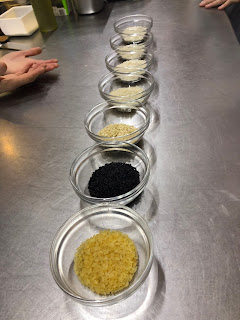The Benedetto Cavalieri Pasta Factory
On Thursday, we traveled to the Benedetto Cavalieri pasta factory which is about 50 minutes from Ugento. This factory has been around since 1918 and there has been 4 generations of Cavalieri to run it. We met the current owner, Andrea Cavalieri, who brought us around for a tour of his factory. In 1918, his great grandfather decided to turn the wheat grain into pasta. This factory is a traditional one, not an industrial producer. They ship their pasta worldwide, but stick to their roots of production. An industrial producer focuses on producing high quantities everyday and they are less worried about the quality. They take 2-3 hours to produce a pasta from start to packaging because they heat the pasta at a very high temperature. Although this is cheaper, it does not produce a high quality pasta. A traditional producer may take 36-44 hours to dry out the pasta because the temperature is half of what the industrial producers use. This allows them to control the protein structure in the pasta and does not destroy the gluten. Furthermore, the pasta will hold different sauces better because of this.
They use cold water when kneading the dough because you dont want to stress the dough too much. When the dough is pushed through the molds, it is heated. Then, when it is dried, it is heated again. Therefore, when they can introduce a colder temperature, they do. At there factory, they produce 40 different types of pasta and 8 of them are organic whole wheat shapes. They are also looking into producing a high quality gluten free pasta. They are researching how to remove the enzyme that reacts with celiac disease instead of using another product like rice flours etc.
I decided to look into more of the history of Benedetto Cavalieri pasta... here is what I found:
July 7, 1918: Benedetto Cavalieri with 83 collaborators, inaugurates the Molino e Pastificio Benedetto Cavalieri with the intent to produce pasta.
Instead of drying the pasta in the streets like they did back then, he invented a system, Metdo Cirillo, which dried the pasta in specific rooms with a hot water radiator and large fan.
The developed the "delicate method" of processing the wheat. It does not denature the nutritional value of the wheat.
Fun Fact of the Day:
~ Describe the flour types and their use in Italian Foods.
Flour has a strong influence on the different pasta we made today. In the ravioli dish, I used 00 flour, which is very fine. This helped contribute to the elasticity of the dough. In the mezzelune dish we made on pasta day, we used buckwheat flour, which led to a very stiff dough with almost no stretch. In the North, especially the mountains where this dish originates, they use buckwheat flour and contributes to an earthiness in the pasta.
With love,
Baylee
They use cold water when kneading the dough because you dont want to stress the dough too much. When the dough is pushed through the molds, it is heated. Then, when it is dried, it is heated again. Therefore, when they can introduce a colder temperature, they do. At there factory, they produce 40 different types of pasta and 8 of them are organic whole wheat shapes. They are also looking into producing a high quality gluten free pasta. They are researching how to remove the enzyme that reacts with celiac disease instead of using another product like rice flours etc.
Italian Word of the Day: Grano (wheat)
I decided to look into more of the history of Benedetto Cavalieri pasta... here is what I found:
July 7, 1918: Benedetto Cavalieri with 83 collaborators, inaugurates the Molino e Pastificio Benedetto Cavalieri with the intent to produce pasta.
Instead of drying the pasta in the streets like they did back then, he invented a system, Metdo Cirillo, which dried the pasta in specific rooms with a hot water radiator and large fan.
The developed the "delicate method" of processing the wheat. It does not denature the nutritional value of the wheat.
The grains are stored in deep bins the factory waiting to be turned into pasta. They use the grains withing 1 year, then switch to the new batch.
Spaghettoni is their number one seller and they make it twice a week. The rest of the 39 shapes get divided between the rest of the time.
This is a drying bins still used for special shapes like their crazy wheels. These date back to 1930 and are very important to the factory.
This is how the pasta is dried. The outside ring is exposed to heat and the inside ring is not. This allows for the pasta to relax and not stress it, producing a very high quality pasta.
This is where the pasta is bagged and weighed.
There is a room of 8 women putting the labels and final packaging of the pasta. They are still using hot glue guns to glue things together!
This was their first pasta machine, a remembrance for them of where it all started.
Fun Fact of the Day:
~ Describe the flour types and their use in Italian Foods.
Flour has a strong influence on the different pasta we made today. In the ravioli dish, I used 00 flour, which is very fine. This helped contribute to the elasticity of the dough. In the mezzelune dish we made on pasta day, we used buckwheat flour, which led to a very stiff dough with almost no stretch. In the North, especially the mountains where this dish originates, they use buckwheat flour and contributes to an earthiness in the pasta.
With love,
Baylee










Comments
Post a Comment